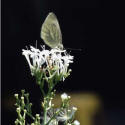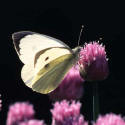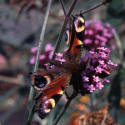Butterfly Photography
Notes on how to photograph butterflies
Butterflies move. They are relatively small compared to other photographic subjects. They fly on sunny days when there are often deep shadows and patches of bright light. All these factors make photographing butterflies a challenge.
Here are a few points to consider:
Wind
If you want to photograph butterflies, first try photographing flowers; you might be surprised by how much flowers move about in the wind. I've found that wind usually comes in small gusts and it's a matter of timing to catch the subject when still.
Background
You can concentrate so hard on the butterfly that you fail to see what is in the background of your viewfinder. A bright yellow plastic stool does not enhance the picture. The bright blobs of colour may be other flowers. Often a slight change of angle can improve a shot.
Position in Frame
Most close-ups of butterflies will have the butterfly in the centre of the frame but sometimes an off-centre shot showing the surroundings can make an excellent image.
Angle of View
If taking a 'Record Photograph' - that is a view of the top of the open wings or a view from the side - then try to position the camera lens parallel to the wings.
If you want a more interesting picture, then try a different angle, for example, face on. Focus on the eyes and antennae.
Angle of the Sun
Which direction is the sun shining from? If you position yourself so that the sun is behind the butterfly - known as contre jour or backlighting - then you may get a more interesting picture. This works particularly well for the Whites.
Exposure
Whites and Blues are usually brighter than the surrounding foliage and Red Admirals darker. Therefore it's desirable to meter the light falling on the butterfly only and not the rest of the scene - can you compensate for this with your camera?
Perfection
Look at your butterfly. Is it intact? Are bits of the wings missing? This is common but it's rare to see a photo of a damaged butterfly. We humans like perfection. Some of these disabled butterflies can be interesting subjects though.
Final tips
Try to move in slowly towards the butterfly without any sudden or jerky movements. Try not to let your shadow fall on the butterfly. Take one picture as you approach. Take another when you've moved in closer.
My photographic equipment
From June 2003, I started using a Nikon Coolpix 4500 digital camera. Most of the pictures on this website from 2003, were taken using that camera.
However I continued to use my Canon EOS 500 (SLR) camera containing slide film, together with my 100mm Vivitar Macro Lens or sometimes a 75-300mm Canon zoom lens (at 300mm). These produced all the images dated between 1998 and 2002.



